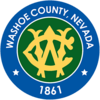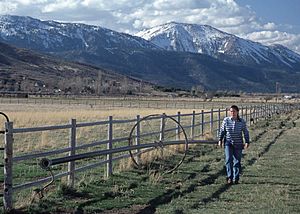Washoe County, Nevada facts for kids
Quick facts for kids
Washoe County
|
||
|---|---|---|
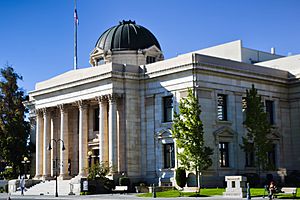
Washoe County Courthouse
|
||
|
||
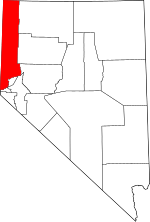
Location within the U.S. state of Nevada
|
||
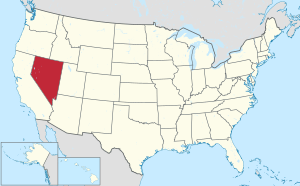 Nevada's location within the U.S. |
||
| Country | ||
| State | ||
| Founded | November 25, 1861 | |
| Named for | Washoe people | |
| Seat | Reno | |
| Largest city | Reno | |
| Area | ||
| • Total | 6,542 sq mi (16,940 km2) | |
| • Land | 6,302 sq mi (16,320 km2) | |
| • Water | 240 sq mi (600 km2) 3.7% | |
| Population
(2020)
|
||
| • Total | 486,492 | |
| • Estimate
(2023)
|
498,022 |
|
| • Density | 74.364/sq mi (28.7123/km2) | |
| Time zone | UTC−8 (Pacific) | |
| • Summer (DST) | UTC−7 (PDT) | |
| Congressional district | 2nd | |
Washoe County (/ˈwɒʃoʊ/) is a county in the U.S. state of Nevada. As of the 2020 census, the population was 486,492, making it Nevada's second-most populous county. Its county seat is Reno. Washoe County is included in the Reno, NV Metropolitan Statistical Area.
Contents
History
Washoe County was created on November 25, 1861, as one of the original nine counties of the Nevada Territory. It is named after the Washoe people who originally inhabited the area. It was consolidated with Roop County in 1864. Washoe City was the first county seat in 1861 and was replaced by Reno in 1871.
In 1911, a small band of Shoshone and Bannock led by Mike Daggett killed four stockmen in Washoe County. A posse was formed, and on February 26, 1911, at the Battle of Kelley Creek, eight of Daggett's band were killed, along with one member of the posse, Ed Hogle. Three children and a woman who survived the battle were captured. The remains of some of the members of the band were repatriated from the Smithsonian Institution to the Fort Hall Idaho Shoshone-Bannock Tribe in 1994.
In 1918, Washoe County elected the first woman elected to the Nevada Legislature, Sadie Hurst, a Republican.
As of 2013, "Washoe County is the first school district in the state to offer Paiute classes," offering an elective course in the Paiute language at Spanish Springs High School and North Valleys High School.
Geography
According to the U.S. Census Bureau, the county has a total area of 6,542 square miles (16,940 km2), of which 6,302 square miles (16,320 km2) is land and 240 square miles (620 km2) (3.7%) is water. The highest point in Washoe County is Mount Rose at 10,785 ft (3,287 m), while the most topographically prominent peak is Virginia Peak.
There are two incorporated cities within the county, namely Reno and Sparks. In 2010, there was a ballot question asking whether the Reno city government and the Washoe County government should become one combined governmental body. According to unofficial results the day after the election, 54% of voters approved of the ballot measure to consolidate the governments.
The Truckee Meadows of Washoe County starts at the furthest southern runway of Reno Tahoe International Airport, GPS Coordinates 39.468836,-119.770912 and runs south east. Rattle Snake Mountain at Huffaker Park, follows the span of Steamboat Creek to the southern east end of Washoe County. This is the last of the range/prairie and wild grass water shed from the eastern range of the Reno Tahoe basin.
Adjacent counties
- Lake County, Oregon – north
- Harney County, Oregon – northeast
- Humboldt County – east
- Pershing County – east
- Churchill County – east
- Lyon County – southeast
- Storey County – south
- Carson City – south
- Placer County, California – southwest
- Nevada County, California – west
- Sierra County, California – west
- Lassen County, California – west
- Modoc County, California – west
Major highways
 I‑80
I‑80 Interstate 80 Business (Verdi)
Interstate 80 Business (Verdi) Interstate 80 Business (Reno–Sparks)
Interstate 80 Business (Reno–Sparks) Interstate 80 Business (Wadsworth–Fernley)
Interstate 80 Business (Wadsworth–Fernley) I‑580
I‑580 U.S. Route 395
U.S. Route 395
 U.S. Route 395 Alternate
U.S. Route 395 Alternate
 U.S. Route 395 Business (Reno)
U.S. Route 395 Business (Reno) SR 28
SR 28 SR 341
SR 341 SR 425
SR 425 SR 426
SR 426 SR 427
SR 427 SR 430
SR 430 SR 431
SR 431 SR 439
SR 439 SR 443
SR 443 SR 445
SR 445 SR 446
SR 446 SR 447
SR 447 SR 647
SR 647 SR 648
SR 648 SR 653
SR 653 SR 655
SR 655 SR 659
SR 659 SR 667
SR 667 SR 668
SR 668 SR 671
SR 671 SR 673
SR 673 SR 877
SR 877 SR 878
SR 878 SR 880
SR 880
National protected areas
- Anaho Island National Wildlife Refuge
- Black Rock Desert-High Rock Canyon Emigrant Trails National Conservation Area (part)
- Sheldon National Wildlife Refuge (part)
- Toiyabe National Forest (part)
Demographics
| Race / Ethnicity | Pop 2010 | Pop 2020 | % 2010 | % 2020 |
|---|---|---|---|---|
| White alone (NH) | 278,213 | 287,862 | 66.02% | 60.90% |
| Black or African American alone (NH) | 9,088 | 11,527 | 2.16% | 2.37% |
| Native American or Alaska Native alone (NH) | 5,782 | 5,790 | 0.19% | 0.19% |
| Asian alone (NH) | 21,288 | 28,063 | 5.05% | 5.77% |
| Pacific Islander alone (NH) | 2,358 | 3,250 | 0.23% | 0.67% |
| Some Other Race alone (NH) | 673 | 2,485 | 0.16% | 0.51% |
| Mixed Race/Multi-Racial (NH) | 10,281 | 23,445 | 2.44% | 4.82% |
| Hispanic or Latino (any race) | 93,724 | 122,204 | 22.24% | 25.12% |
| Total | 421,407 | 486,492 | 100.00% | 100.00% |
| Historical population | |||
|---|---|---|---|
| Census | Pop. | %± | |
| 1870 | 3,091 | — | |
| 1880 | 5,664 | 83.2% | |
| 1890 | 6,437 | 13.6% | |
| 1900 | 9,141 | 42.0% | |
| 1910 | 17,434 | 90.7% | |
| 1920 | 18,627 | 6.8% | |
| 1930 | 27,158 | 45.8% | |
| 1940 | 32,476 | 19.6% | |
| 1950 | 50,205 | 54.6% | |
| 1960 | 84,743 | 68.8% | |
| 1970 | 121,068 | 42.9% | |
| 1980 | 193,623 | 59.9% | |
| 1990 | 254,667 | 31.5% | |
| 2000 | 339,486 | 33.3% | |
| 2010 | 421,407 | 24.1% | |
| 2020 | 486,492 | 15.4% | |
| 2023 (est.) | 498,022 | 18.2% | |
| U.S. Decennial Census 1790–1960 1900–1990 1990–2000 2010–2020 |
|||
2010 census
As of the 2010 United States census, there were 421,407 people, 163,445 households, and 102,768 families living in the county. The population density was 66.9 inhabitants per square mile (25.8/km2). There were 184,841 housing units at an average density of 29.3 per square mile (11.3/km2). The racial makeup of the county was 76.9% white, 5.2% Asian, 2.3% black or African American, 1.7% American Indian, 0.6% Pacific islander, 9.5% from other races, and 3.8% from two or more races. Those of Hispanic or Latino origin made up 22.2% of the population. In terms of ancestry, 16.9% were German, 13.1% were Irish, 11.8% were English, 7.2% were Italian, and 4.7% were American.
Of the 163,445 households, 32.0% had children under the age of 18 living with them, 45.6% were married couples living together, 11.3% had a female householder with no husband present, 37.1% were non-families, and 27.2% of all households were made up of individuals. The average household size was 2.55 and the average family size was 3.11. The median age was 37.0 years.
The median income for a household in the county was $55,658 and the median income for a family was $67,428. Males had a median income of $46,653 versus $35,559 for females. The per capita income for the county was $29,687. About 8.5% of families and 12.6% of the population were below the poverty line, including 17.0% of those under age 18 and 6.4% of those age 65 or over.
2016
The Demographics of Washoe County covers 6,540.4 square miles. There are approximately 42,154 households in the unincorporated areas with an estimated population of 419,948. The average household size in 2007 was estimated at 2.70. The Truckee Meadows Fire Protection District is charged with fire protection and emergency services in the unincorporated areas of the county.
Communities
Cities
Census-designated places
Other unincorporated communities and ghost towns
- Deep Hole
- Flanigan
- Galena
- New Washoe City
- Poeville
- Pleasant Valley
- Pyramid
- Pyramid City
- Steamboat Springs
- Vya
- Washoe City
Education
Washoe County School District is the school district for the entire county.
The Bureau of Indian Education-contracted Pyramid Lake Schools is in Nixon.
There is a charter school, Coral Academy of Science; and these private schools: Bishop Manogue High School and Excel Christian School.
University of Nevada, Reno is in Reno.
Washoe County Library System is the public library system.
Notable residents
- Nellie Shaw Harnar, historian and educator
- Jeremy Renner, actor best known for his role as Hawkeye in the Marvel Cinematic Universe franchise
See also
 In Spanish: Condado de Washoe para niños
In Spanish: Condado de Washoe para niños


